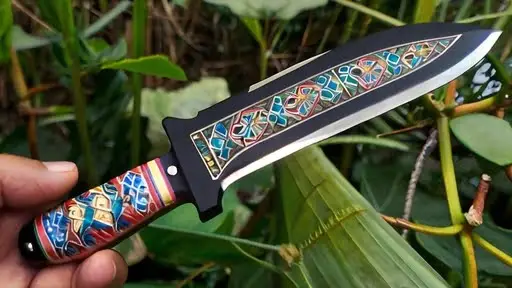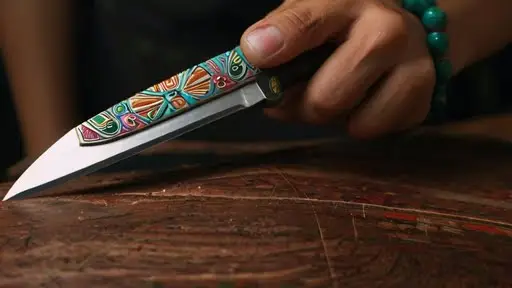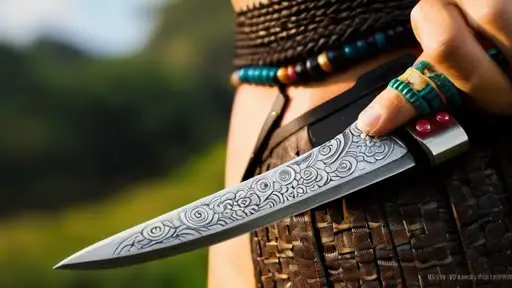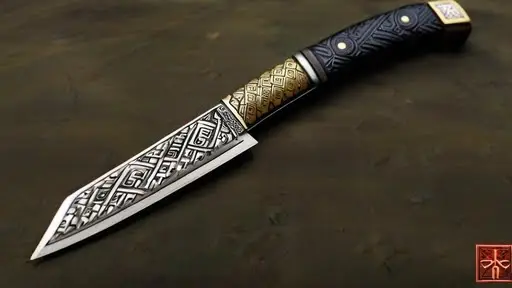The Hmong Knife is a unique implement is a cultural treasure from the Hmong people, not merely something to chop with. It narrates a tale involving art, culture, and history. Ideal for youthful adventurers, we shall discover the significance of this knife on our voyage. Prepare to explore the fascinating world of the Hmong knife, from its distinctive design to its practical use.

What is a Hmong knife?
A distinctive and essential instrument in Hmong culture, the knife is often employed in everyday tasks and customary rituals. Carefully crafted, this knife is unique in both its look and functionality. It represents talent and tradition in addition to being a tool. The knife, made by Hmong craftspeople in the old fashion, has excellent artistry and delicate features. It is multipurpose and perfect for gardening, cooking, and crafts. The Hmong knive is more than a helpful tool. It symbolizes ethnic pride that spans generations due to its timeless appeal. It is ideal for many jobs and represents the inventiveness and tenacity of the Hmong people.
What is a Hmong knife used for?

An ancient instrument used by the Hmong people, the knife has a long history and a variety of applications.
- Traditional Significance: An integral part of the Hmong cultural legacy, the knife is more than a tool. It is a centuries-old emblem of expertise and tradition used by the Hmong people, an ethnic group in Southeast Asia.
- Daily Use: This knife is a multifunctional instrument. Everyday tasks like farming, cooking, and crafting involve its utilization. The Hmong knive is a valuable tool for slicing vegetables and cutting bamboo.
- Cultural Ceremonies: In the Hmong tradition, people use knives in certain rituals, symbolizing protection and adherence to customs, and often incorporate them into ceremonies.
- Arts and Crafts: The Hmong people, renowned for their artistic talents, showcase their creative abilities by creating exquisite wood carvings and lovely fabrics using knives.
- Symbol of Identity: Carrying a Hmong knive preserves and showcases Hmong identity pride, helping the next generation feel more connected to their roots.
- Self-defense Weapon: The Hmong knive, with a long history of use for self-defense, provided protection and stability in difficult times.
- Farming Assistance: Knives are essential for Hmong farmers. It facilitates field management and crop harvesting, which eases agricultural responsibilities.
- Compact and Convenient: Its small size makes carrying it simple. The Hmong people usually keep it in a sheath, so it’s always ready to go.
- Handmade Quality: Skillfully crafted by artisans, every Hmong knive is distinct. The tool gains intrinsic worth from its quality.
- Education and Preservation: Students can understand cultural diversity and the preservation of their heritage by studying about the Hmong knive.
The Significance of the Hmong Knife

In the history and day-to-day activities of the Hmong people, the Hmong knife is an essential cultural emblem. We will examine the distinctive qualities of the Hmong knife, highlighting its importance in many areas of Hmong society.
Cultural Relevance of hmong knife
The Hmong knife is more than just a tool; it represents culture. It depicts the Hmong people’s tenacity and their connection to their ancestors. This knife has been a part of their daily lives for ages, used for hunting, farming, and even customary rites.
Background History
The Hmong knife has been essential historically. It served as a survival companion, shielding from animals and assisting in slicing through impenetrable woodlands. Stories and history have been handed down with this knife throughout the years.
Design and Artistry
Hmong craftsmen make knives with a distinctive pattern, showcasing their skills in the crafting process. Every knife has elaborate patterns and decorations, making it a work of art and a helpful tool.
Place in Everyday Life
The Hmong knife is an adaptable instrument for everyday use. People use it in farming, food preparation, and even tool-making. It represents the Hmong people’s strong sense of self-reliance and capacity to exist on the soil.
Identifier Symbol of hmong knife
The knife is more than just a practical tool; it represents Hmong culture. It is a symbol of their power, heritage, and customs. Hmong people maintain a connection to their heritage by carrying this knife.
Knowledgeable Aspect
The Hmong knive offers young students a glimpse into a distinct cultural perspective. It imparts knowledge about variety, history, and the value of keeping cultural artefacts intact. Discovering the history and culture of the Hmong knife may be a fascinating experience.
How to clean and sanitize Hmong Knife?

A Hmong knive’s upkeep and durability depend on regular cleaning and sanitization. Here’s a short, detailed how-to for maintaining the best possible condition for your Hmong knife:
1. Gently Cleaning of hmong knife
Wash the knife lightly first. With a gentle sponge, use warm, soapy water. With the blade, use caution—it’s sharp! Clean the handle and the blade together. This keeps the knife clean and safe to use.
2. Splashing utterly
Thoroughly rinse the knife under running water after cleaning. Make sure you’ve used up all the soap. This step is crucial in avoiding soap residue; this site’s appearance and functionality may be impacted by soap residue.
3. Quick Drying of hmong knife
Using a fresh towel, immediately dry the knife. Avoid letting it air dry. If kept damp, rust or water stains may appear. The blade maintains its new-like sheen when it dries fast.
4. Cleaning for Security
Washing and sanitizing are different. The knife is very clean as a result. Use a mixed vinegar and water or a food-safe sanitizer. Use this solution to wipe the blade and handle. Rinse it with clean water once again after that.
5. Lubricating the Blade
A unique step is to oil the blade. Someone shields and maintains the metal in excellent condition. On a gentle cloth, apply a little bit of cooking oil. Apply a light touch to the blade. This lessens the chance of corrosion.
6. Secure Keep
Finally, put your knife in a secure location. Sheaths or knife blocks are helpful accessories. This avoids mishaps and keeps the knife closed. Moreover, it keeps the knife spotless and prepared for usage again.
In Wrapping Up
In addition to being an essential tool for the Hmong people, the knife is a noteworthy representation of their rich cultural history. It is a critical component of their everyday lives and a physical link to their history. The Hmong knive’s history, artistic expression, and cultural significance make for an intriguing tale. We should all tell and celebrate this tale because it enables us to recognize and value the diversity of our global community.


Заказать такси https://taxi-gukovo.ru эконом в Гуково дешево с отзывами, ценами и телефонами, онлайн заказ.
Профессиональный уход за Вашим автомобилем в Москве, получите консультацию.
Детейлинг сервис – https://deteylingmoscowcenter.ru .
вавада рабочее на сегодня vavada casino зеркало рабочее
Следующая страница [url=https://Kraken21att.net]kraken21.at[/url]
official website [url=https://counterwallet.info/]counter wallet[/url]
read [url=https://simplehold.pro/]simplehold wallet[/url]
use this link [url=https://infinitowallet.pro/]infinito[/url]
[url=https://xn—–8kcaaomxdpelhyeeqjefp6c.xn--p1ai/%D1%83%D1%81%D0%BB%D1%83%D0%B3%D0%B8/%D0%B0%D1%80%D0%B5%D0%BD%D0%B4%D0%B0_%D1%8F%D1%85%D1%82_%D0%B8_%D0%BA%D0%B0%D1%82%D0%B5%D1%80%D0%BE%D0%B2_%D0%B2_%D0%B0%D0%BD%D0%B0%D0%BF%D0%B5]Аренда яхт и катеров в Анапе[/url] – Морские прогулки в Анапе, Экскурсия Кольцо предгорья
[url=https://kraken8tor.com/]сайт кракен тор[/url] – ссылка на кракен в тор, кракен тор зеркало
узнать [url=https://Kraken21att.net/]kraken20.at[/url]
[url=https://kraken16at.co/]кракен даркнет[/url] – kraken13, kraken 17at
[url=https://trjpscan.top]трипскан[/url] – tripscan top войти в личный, tripscan top войти
official website [url=https://cakevvallet.com/]cake wallet Safari[/url]
important site [url=https://samouraiwallet.io]wallet samourai[/url]
опубликовано здесь https://kp-inform.ru/catalog/msa/disk-hpe-msa-3-2tb-12g-sas-sff-2-5-ssd-841501-001-for-msa
[url=https://poisk-lekarstv.su/lekarstva/ozempik-1mg-3ml-5/]шприцы +для саксенды[/url] – саксенда инструкция +по применению цена, оземпик +в новосибирске
this website
[url=https://fillersmarket.com/product/metoo-fill-deep/]Metoo Fill Deep[/url]
наркологическая скорая бесплатная [url=https://skoraya-narkologicheskaya-pomoshch11.ru/]наркологическая скорая бесплатная [/url] .
скорая наркологическая помощь в москве [url=https://skoraya-narkologicheskaya-pomoshch12.ru/]скорая наркологическая помощь в москве[/url] .
Hi my friend! I wish to say that this post is amazing, nice written and include almost all vital infos. I would like to see more posts like this.
новые виды услуг в мире [url=http://biznes-idei12.ru]http://biznes-idei12.ru[/url] .
Вывод из запоя в Алматы [url=https://www.fizioterapijakeskic.com]Вывод из запоя в Алматы [/url] .
бизнес идея [url=biznes-idei13.ru]бизнес идея[/url] .
Профессиональный сервисный центр по ремонту бытовой техники с выездом на дом.
Мы предлагаем: сервис центры бытовой техники красноярск
Наши мастера оперативно устранят неисправности вашего устройства в сервисе или с выездом на дом!
Кодировка от алкоголизма в Алматы цена [url=https://kodirovanie-ot-alkoholizma-v-almaty.kz/]Кодировка от алкоголизма в Алматы цена [/url] .
геолокация по номеру телефона [url=www.poisk-po-nomery.ru/]геолокация по номеру телефона[/url] .
курс доллар тенге [url=https://kursy-valut-online.kz]курс доллар тенге[/url] .
Evakuator-Mow [url=https://evakuator-mow.ru/]https://evakuator-mow.ru/[/url] .
instagram stories [url=https://www.anoninststories.com]https://www.anoninststories.com[/url] .
instagram stories without [url=http://storyanonviewer.com]instagram stories without[/url] .
лечение алкоголизма диспансер [url=https://xn—–7kcablenaafvie2ajgchok2abjaz3cd3a1k2h.xn--p1ai/]https://xn—–7kcablenaafvie2ajgchok2abjaz3cd3a1k2h.xn--p1ai/[/url] .
instagram story viewer [url=http://anstoriesview.com]instagram story viewer[/url] .
instagram account [url=https://anonstoriesview.com/]instagram account[/url] .
instagram profile viewer [url=https://anon-story-view.com/]instagram profile viewer[/url] .
Heya! I’m at work browsing your blog from my new iphone! Just wanted to say I love reading your blog and look forward to all your posts! Carry on the fantastic work!
Very interesting information!Perfect just what I was searching for!
How soon do you think web crawler will pickup my blog posts?
Thanks for every other informative blog. Where else could I get that type of information written in such an ideal manner? I’ve a venture that I’m just now running on, and I have been at the look out for such information.
New to joomla please guide me i have download joomla from website ? What should i do ?.
Купите современную коляску-трость для вашего малыша, со съемным козырьком и регулируемой спинкой.
Новейшая коляска-трость с механизмом складывания одной рукой, и удобным выдвижным козырьком.
Модная коляска-трость для маленького модника, которая станет вашим незаменимым помощником.
Качественная коляска-трость с удобной ручкой, и мягкими ремнями безопасности.
babyhit wonder [url=https://kolyaski-trosti-progulochnye.ru/]https://kolyaski-trosti-progulochnye.ru/[/url] .